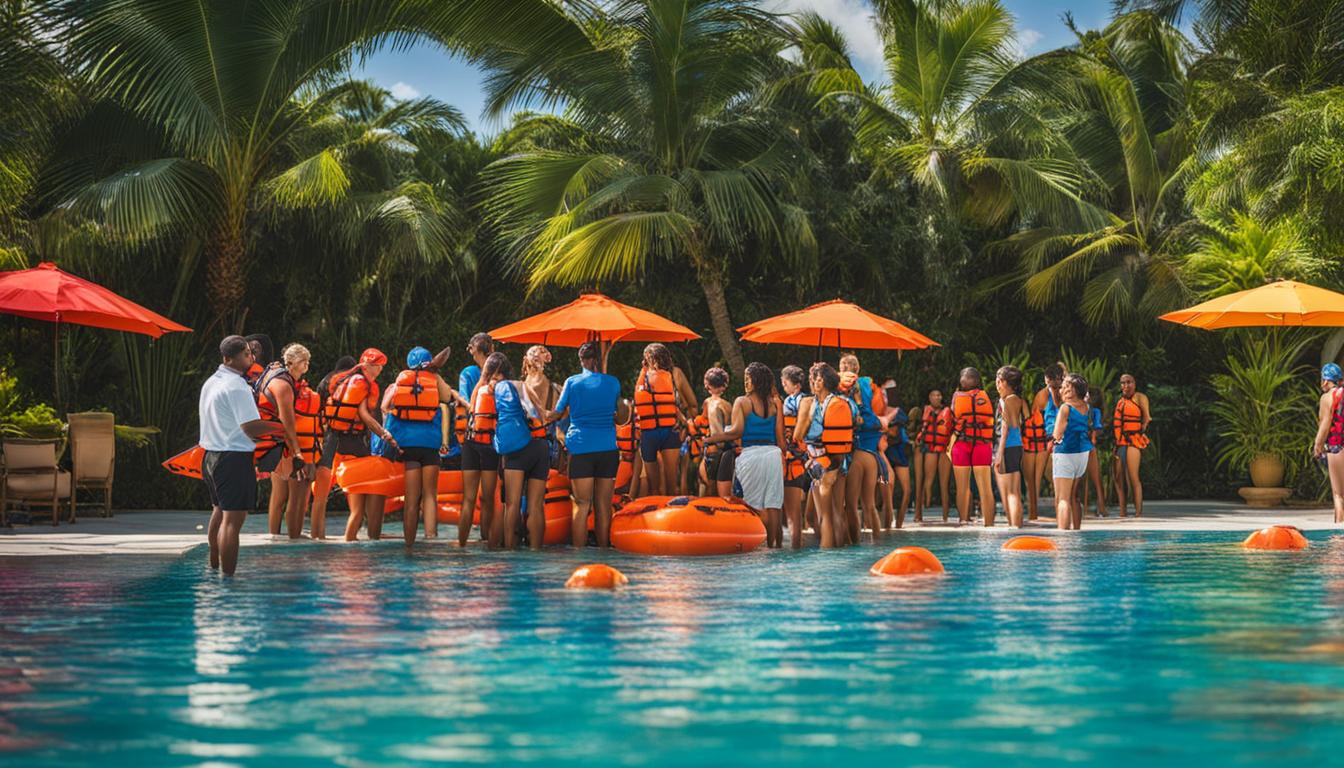Welcome to our article on wet exit workshops, where we explore how these sessions can enhance your safety as a kayaker. Whether you’re a beginner or an experienced paddler, wet exit training workshops provide invaluable hands-on practice for dealing with a capsize and regaining control in challenging water conditions. Let’s dive in and discover the benefits of these workshops, the importance of participating in them, and the hierarchy of controls for water safety.
Key Takeaways:
- Wet exit workshops teach important skills for safely exiting a capsized kayak and regaining control.
- Participating in these workshops enhances kayak safety by building essential skills and knowledge.
- The hierarchy of controls provides a step-by-step approach to eliminating or reducing workplace hazards.
- Wet exit workshops offer numerous benefits, including improved confidence and preparedness for real-life scenarios.
- By participating in comprehensive wet exit training, kayakers can ensure their safety and enjoyment on the water.
The Importance of Wet Exit Workshops for Kayakers
Participating in wet exit workshops is crucial for kayakers to enhance their safety and build essential skills for handling a capsized kayak. These workshops provide a unique opportunity for kayakers to practice wet exits and rescue techniques in a safe and controlled environment. By simulating real-life scenarios, participants can develop the confidence and proficiency necessary to effectively handle a capsize and regain control in challenging water conditions.
One of the key benefits of wet exit workshops is the focus on skill building. Participants learn proper body positioning, paddle placement, and self-rescue methods, which are essential for a successful wet exit. Additionally, these workshops teach participants how to manage their fears and stay calm during a capsize, ensuring a composed and effective response. By honing these skills, kayakers can improve their overall safety on the water and mitigate the risks associated with capsizing.
Furthermore, wet exit workshops serve as valuable kayak safety education programs. In addition to practicing wet exit techniques, participants gain knowledge about important topics such as buoyancy aids, communication devices, and hazard awareness. These educational components provide kayakers with a comprehensive understanding of safety measures and equip them with the necessary tools to prevent accidents or handle emergencies while out on the water.
Table: Benefits of Participating in Wet Exit Workshops
| Benefits | Description |
|---|---|
| Enhanced Safety | Develops crucial skills to handle capsized kayaks and regain control in challenging water conditions. |
| Improved Confidence | Teaches participants how to manage fears and stay calm during a capsize, boosting confidence in their abilities. |
| Comprehensive Education | Covers important topics such as buoyancy aids, communication devices, and hazard awareness. |
| Effective Skill Building | Focuses on proper body positioning, paddle placement, and self-rescue techniques for a successful wet exit. |
| Risk Mitigation | Equips kayakers with the necessary tools and knowledge to prevent accidents or handle emergencies on the water. |

By participating in wet exit workshops, kayakers can develop essential skills and knowledge to handle a capsized kayak effectively. These workshops provide a safe and controlled environment for participants to practice wet exits and rescue techniques, ensuring that they are prepared for real-life scenarios.
Overall, wet exit workshops are a valuable investment in kayak safety. They provide kayakers with the opportunity to enhance their skills, build confidence, and gain comprehensive education on safety measures. By participating in these workshops, kayakers can minimize risks, improve their overall safety on the water, and ensure a more enjoyable paddling experience.
The Hierarchy of Controls for Water Safety
The hierarchy of controls is a fundamental approach to managing and reducing workplace hazards, including water safety. It provides a structured framework for identifying and implementing the most effective control measures to mitigate risks. In the context of wet exit workshops, the hierarchy of controls includes three main categories: engineering controls, work practice controls, and administrative controls.
Engineering Controls
Engineering controls focus on modifying the physical environment to eliminate or minimize hazards. In the context of water safety, engineering controls can include the installation of safety barriers, such as guardrails or fencing, to prevent accidental falls into the water. Another example is the use of personal flotation devices (PFDs) or buoyancy aids, which provide an additional layer of protection and help keep individuals afloat in case of a capsize.
Work Practice Controls
Work practice controls involve implementing safe work procedures and practices to reduce the likelihood of accidents and injuries. In the context of wet exit workshops, work practice controls may include establishing clear guidelines for proper kayak handling and maneuvering techniques. Participants are trained on how to maintain a balanced and stable position while kayaking, reducing the risk of capsizing and the need for a wet exit. Regular practice sessions and drills also reinforce these safe work practices and help build muscle memory for quick and efficient responses during a capsize.
Administrative Controls
Administrative controls focus on implementing policies, training, and awareness programs to promote safe behavior and ensure compliance with safety regulations. In the context of wet exit workshops, administrative controls may involve conducting pre-workshop safety briefings that highlight the importance of proper wet exit techniques and the potential risks of not following them. Instructors also provide ongoing guidance and feedback to participants, reinforcing safety protocols and promoting a culture of water safety awareness.
| Category | Description | Examples |
|---|---|---|
| Engineering Controls | Modifying the physical environment to eliminate or minimize hazards | Installation of safety barriers, use of personal flotation devices |
| Work Practice Controls | Implementing safe work procedures and practices | Establishing guidelines for kayak handling, regular practice sessions |
| Administrative Controls | Implementing policies, training, and awareness programs | Safety briefings, ongoing guidance and feedback |
Benefits of Participating in Wet Exit Workshops
Participating in wet exit workshops offers numerous benefits for kayakers. Whether you are a beginner or an experienced paddler, these sessions provide invaluable opportunities to enhance your skills, build confidence, and ensure your safety on the water.
Skill Building in a Group Setting
One of the key advantages of wet exit workshops is the opportunity to learn in a group setting. These sessions often involve a small group of kayakers, allowing participants to observe and learn from each other’s experiences. By watching how others perform wet exits and rescue techniques, you can gain valuable insights and improve your own skills.
Furthermore, practicing wet exits in a group setting creates an environment that closely simulates real-life scenarios. This helps you become familiar with the challenges that may arise during a capsize and teaches you how to respond effectively in a supportive and controlled setting. The collaborative nature of group wet exit training fosters a sense of camaraderie among participants, creating a positive and encouraging learning environment.
Comprehensive Training for Kayakers
Wet exit workshops provide comprehensive training that goes beyond simply learning how to exit a capsized kayak. These sessions cover a wide range of topics related to kayak safety, including self-rescue techniques, hazard awareness, and proper use of safety equipment. By participating in these workshops, you can acquire a well-rounded skillset that prepares you to handle various situations on the water.
Comprehensive wet exit training also focuses on building confidence and managing fear during a capsize. These workshops emphasize the importance of staying calm and composed, which is critical for executing a successful wet exit. By practicing in a controlled environment and receiving guidance from experienced instructors, you can develop the mental fortitude needed to navigate challenging situations with ease.
Enhanced Safety for Kayakers
Ultimately, participating in wet exit workshops significantly enhances your safety as a kayaker. These sessions equip you with the knowledge and skills to handle a capsized kayak effectively, minimizing the risks associated with such incidents. By learning proper body positioning, paddle placement, and self-rescue techniques, you can quickly regain control and safely return to your kayak.
In addition, wet exit workshops also provide valuable education on safety equipment and hazard awareness. You will learn about the importance of wearing buoyancy aids, carrying communication devices, and being aware of potential hazards in the water. This comprehensive approach to safety ensures that you are well-prepared to handle any unforeseen circumstances that may arise during your kayaking adventures.
Participating in wet exit workshops is a vital step towards becoming a confident and competent kayaker. These sessions offer the opportunity to build skills, learn from others, and enhance your overall safety on the water. By investing in comprehensive wet exit training, you can enjoy your kayaking experiences with peace of mind, knowing that you have the necessary tools to handle any challenges that may come your way. So don’t miss out on the benefits of group wet exit training, join a workshop today and take your kayaking skills to the next level!
Conclusion
Participating in kayak escape technique classes and wet exit workshops is essential for enhancing your safety and enjoyment while kayaking. These sessions provide you with the necessary skills, knowledge, and confidence to effectively handle a capsize and ensure your well-being on the water.
By engaging in comprehensive wet exit training, you can build a strong foundation for safe paddling experiences. These workshops offer a structured environment where you can learn and practice essential techniques such as body positioning, paddle placement, and self-rescue methods.
Whether you choose to join group wet exit training, kayak escape technique classes, or other kayak safety clinics, these workshops contribute significantly to enhancing your overall safety. By equipping yourself with the right skills and knowledge, you can navigate unexpected situations with confidence and enjoy your kayaking adventures to the fullest.
FAQ
What are wet exit workshops?
Wet exit workshops provide hands-on training for kayakers to enhance their safety skills in the event of a capsize. These workshops focus on teaching participants how to safely exit a capsized kayak and regain control in challenging water conditions.
What do wet exit workshops teach?
Wet exit workshops teach participants valuable techniques such as proper body positioning, paddle placement, and self-rescue methods. Participants learn how to handle unexpected situations on the water and develop the confidence and skills needed for a successful wet exit.
Why are wet exit workshops important?
Wet exit workshops play a crucial role in enhancing kayak safety by providing participants with essential skills and knowledge to handle a capsized kayak effectively. These workshops also teach participants how to manage their fears and stay calm during a capsize, which is crucial for a successful wet exit.
What topics are covered in kayak safety education programs?
Kayak safety education programs cover important topics such as buoyancy aids, communication devices, and hazard awareness on the water. These programs ensure that kayakers are well-equipped with the necessary knowledge to stay safe while paddling.
What is the hierarchy of controls for water safety?
The hierarchy of controls is a step-by-step approach to eliminating or reducing workplace hazards, including water safety. It ranks controls from the most effective level of protection to the least effective, and includes engineering controls, work practice controls, and administrative controls.
What are the benefits of participating in wet exit workshops?
Participating in wet exit workshops offers numerous benefits for kayakers. These benefits include building essential skills and knowledge, practicing wet exits and rescue techniques in a safe environment, and developing the confidence to handle real-life scenarios on the water.
How do wet exit workshops contribute to kayak safety education?
Wet exit workshops are an essential part of kayak safety education. These sessions provide kayakers with the necessary skills, knowledge, and confidence to effectively handle a capsize and ensure their safety on the water. By participating in comprehensive wet exit training, kayakers can build their skillset and develop a strong foundation for safe and enjoyable paddling experiences.





